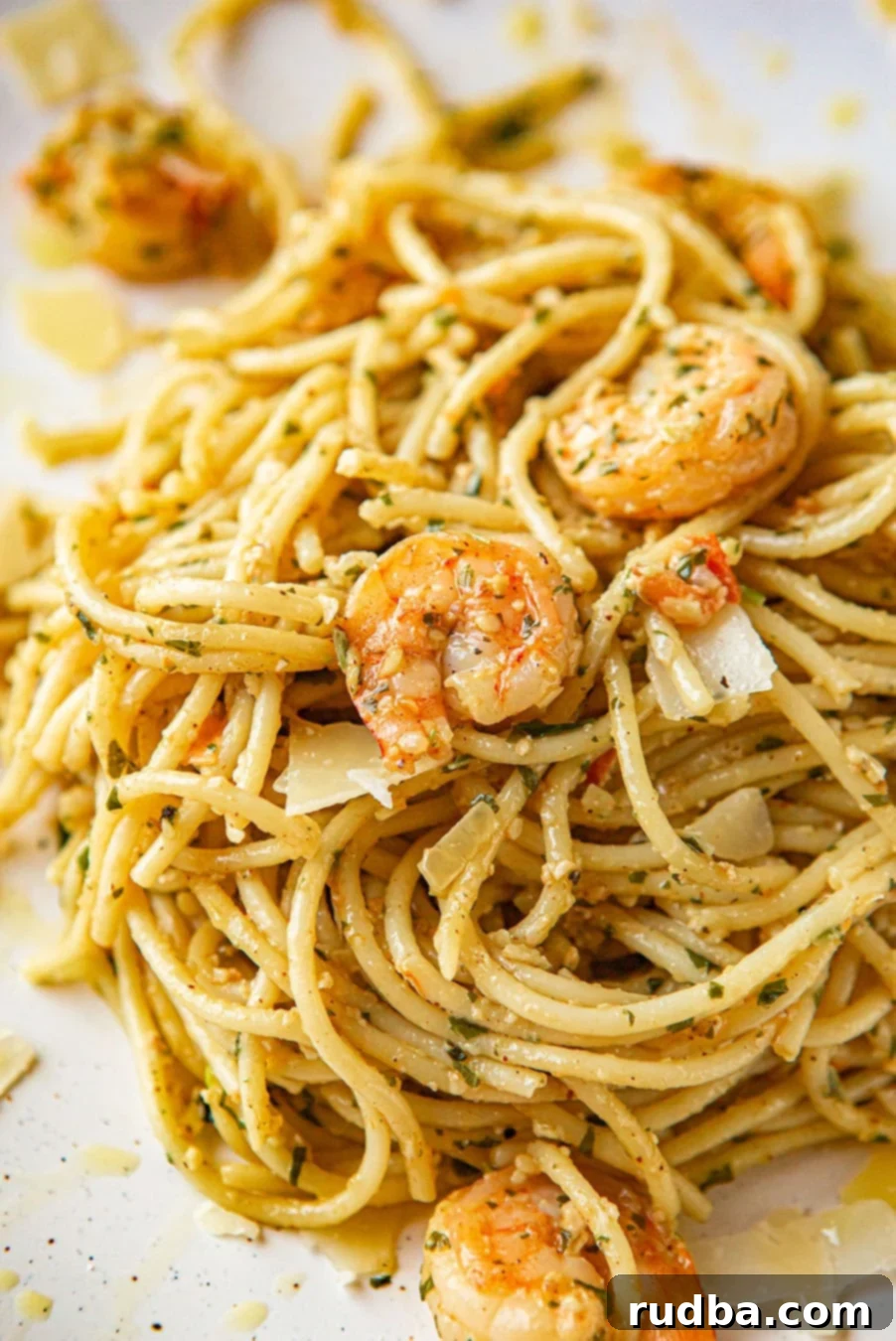Irresistible Shrimp Pesto Pasta: Your Ultimate Guide to a Flavorful Meal
Prepare to delight your taste buds with a dish that truly offers the best of multiple culinary worlds: our exquisite Shrimp Pesto Pasta. This recipe seamlessly blends the rich, aromatic traditions of classic Italian cuisine with the fresh, vibrant flavors of the sea. Imagine perfectly al dente pasta, succulent shrimp, and a bright, herbaceous homemade pesto, all coming together in a symphony of flavor that will make any dinner feel like a special occasion.
At the heart of this dish lies the fresh basil, fragrant garlic, nutty Parmesan cheese, and high-quality olive oil that make up a truly exceptional pesto. When combined with tender, juicy shrimp and your favorite pasta, you get a meal that’s not only incredibly flavorful but also surprisingly simple to prepare. It’s no secret that I have a passion for both pasta and seafood, often mixing the two in delightful creations like my Creamy Shrimp Alfredo Pasta or my Instant Pot Shrimp Alfredo Pasta. There are countless delicious and addictive recipes to explore, but in my opinion, pasta and seafood are simply a match made in culinary heaven.
While store-bought pesto can be convenient, I truly believe that homemade pesto elevates this dish to an entirely new level. The vibrant freshness of basil, the pungent kick of garlic, and the rich nuttiness of toasted pine nuts create a sauce that’s unparalleled. You have complete control over the ingredients, ensuring the highest quality and freshest flavor profile. Once you try this homemade pesto shrimp spaghetti, I’m confident you’ll agree it’s a game-changer.
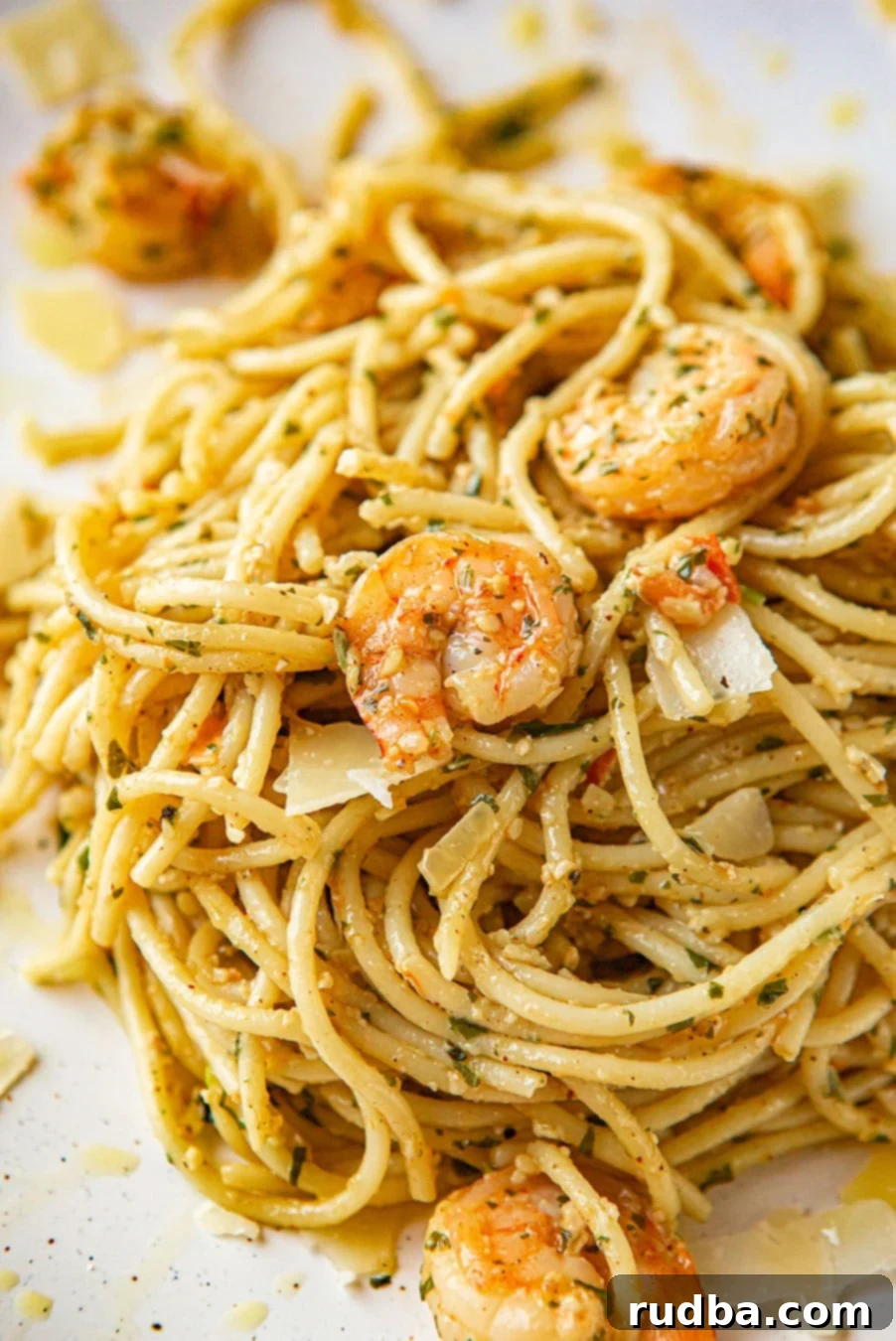
Crafting Your Perfect Shrimp Pesto Pasta: A Step-by-Step Guide
Creating this delicious shrimp pesto pasta is a straightforward process, broken down into three main components: making the pesto, preparing the shrimp, and combining everything with the pasta. Each step is designed to maximize flavor and ensure a perfectly balanced dish.
- Make the Pesto – The secret to an outstanding pesto lies in proper preparation. Start by gently toasting the pine nuts in a dry skillet over medium heat for just about one minute. This brief toasting enhances their natural nutty flavor, adding depth to the pesto. Be careful not to burn them, as they can go from perfectly golden to burnt very quickly. Once toasted, combine all your pesto ingredients – fresh basil, toasted pine nuts, garlic cloves, lemon juice, and Parmesan cheese – in a food processor or blender. As the ingredients begin to blend, slowly drizzle in the olive oil through the feed tube. This emulsifies the sauce, giving it a smooth, creamy texture. Finally, season with salt and freshly ground black pepper to taste, adjusting until the flavor is just right.
- Make the Shrimp – Perfectly cooked shrimp are essential for this dish. Begin by heating a combination of butter and a touch of olive oil in a large skillet over medium heat until the butter is fully melted and slightly shimmering. Add the finely diced onions and cook them until they become translucent and fragrant, which usually takes about 3-5 minutes. This creates a wonderful aromatic base for the shrimp. Next, add the shrimp to the skillet. Season them generously with salt, pepper, and chili powder (if using) and cook for approximately 2 minutes on each side, or until they turn pink and opaque. Avoid overcooking the shrimp, as they can become tough and rubbery.
- Add the Rest – Once your pesto and shrimp are ready, it’s time to bring the dish together. Add the homemade pesto directly into the skillet with the shrimp and cooked onions, stirring to combine. Cook for just about 1 minute to warm the pesto through and allow its flavors to meld with the shrimp. Then, pour in the heavy cream and add the diced tomatoes, cooking for another 15 seconds. Finally, toss in your freshly cooked pasta, stirring gently until every strand is beautifully coated in the creamy, flavorful pesto sauce. If the sauce seems a little thick, a splash of reserved pasta water can help loosen it up. Stir and serve immediately, perhaps with an extra sprinkle of Parmesan cheese.
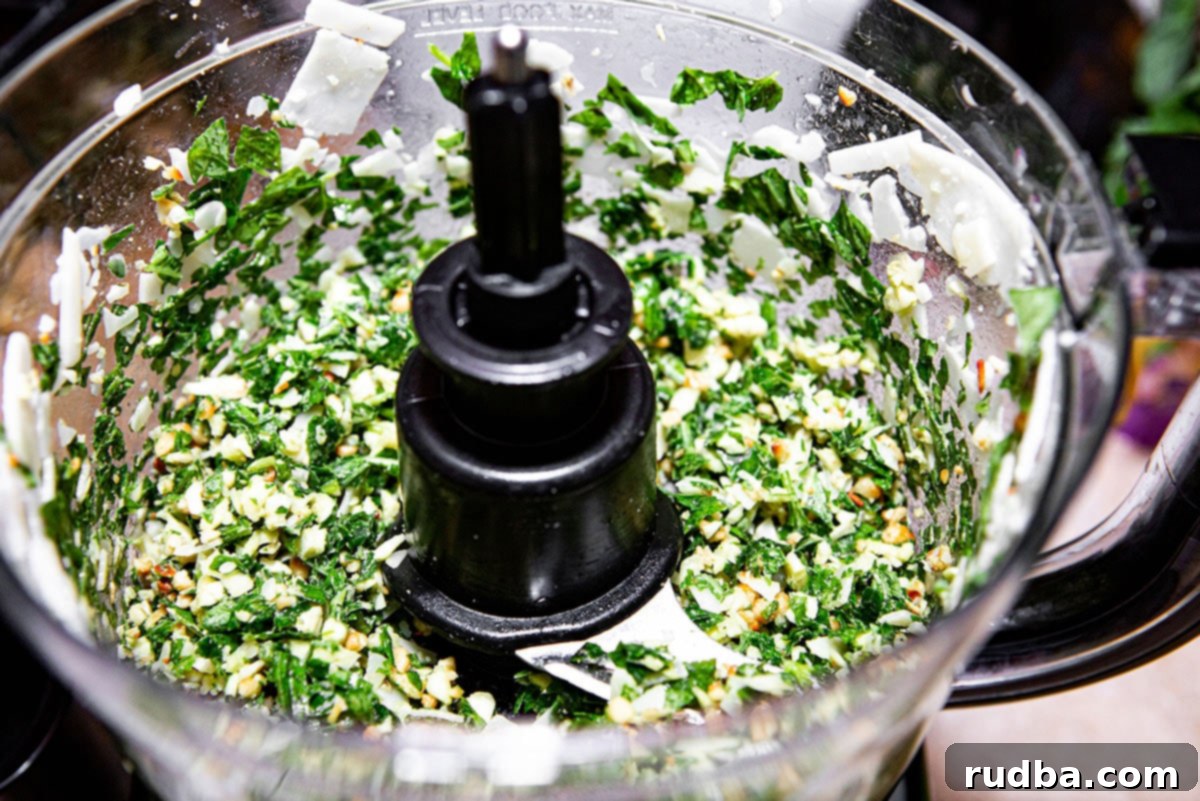
What Pasta is Best with Pesto? Exploring Your Noodle Options
Pesto’s versatility truly shines when paired with pasta, and the beauty is that you can use almost any shape you desire. While some classic pairings exist, personal preference plays a huge role. I often reach for spaghetti because its long, thin strands are excellent at capturing and delivering the vibrant pesto sauce with every bite. The way the sauce clings to the pasta creates a satisfying texture and ensures a burst of flavor in each mouthful.
However, short pasta shapes are equally fantastic and offer a different culinary experience. Think about shapes like bowtie (farfalle), penne, elbow macaroni, rigatoni, or corkscrew (rotini). These shapes, with their nooks, crannies, and hollow centers, are perfect for scooping up and holding onto thicker, chunkier pesto. The sauce nestles within the pasta, creating little pockets of concentrated flavor. Linguine and angel hair pasta are also excellent alternatives if you prefer a long, delicate noodle similar to spaghetti. Ultimately, the best pasta for pesto is one that you enjoy eating and that effectively carries the sauce. Don’t be afraid to experiment with different shapes to find your personal favorite!
Beyond pasta, pesto is incredibly versatile and tastes amazing in various other applications. It can be spread onto sandwiches, swirled into soups, or used as a base for pizza. One of my absolute favorite ways to enjoy pesto is slathered on warm, crusty bread. For instance, it’s a phenomenal addition to Cheesy Garlic Bread, creating an aromatic and intensely flavorful appetizer or side dish.
Is Pesto Healthy? Unpacking the Nutritional Benefits of Pesto
Many wonder if pesto, with its rich olive oil base and cheese, can be considered a healthy option. The good news is, traditional pesto sauce, made with fresh, wholesome ingredients, is generally a very healthy recipe! While every recipe can vary slightly, pesto across the board typically boasts a good nutritional profile, especially when made from scratch.
Let’s look at the key components:
- Fresh Basil: This aromatic herb is packed with antioxidants, vitamins K, A, and C, and essential minerals. It’s known for its anti-inflammatory properties and contributes to overall well-being.
- Olive Oil: A cornerstone of the Mediterranean diet, olive oil is rich in monounsaturated fats, which are considered heart-healthy. These fats can help reduce bad cholesterol levels and provide essential fatty acids.
- Pine Nuts: These small but mighty nuts offer a good source of protein, dietary fiber, vitamin E, and minerals like magnesium and zinc. They contribute healthy fats and a satisfying texture.
- Garlic: Beyond its incredible flavor, garlic has long been recognized for its health benefits, including immune-boosting properties and potential cardiovascular advantages.
- Parmesan Cheese: While cheese should be consumed in moderation, Parmesan provides calcium and protein. Using a high-quality, aged Parmesan adds intense flavor, meaning you often need less to achieve a satisfying taste.
One aspect to consider is sodium content, especially if salt is added generously to the pesto or the pasta water. You can always choose to omit or reduce the amount of added salt in your homemade pesto to lower the sodium intake, making it even healthier. By focusing on fresh, quality ingredients and mindful portion sizes, pesto can absolutely be a nutritious and delicious part of your diet.
Top Tips for the Perfect Shrimp Pesto Pasta: Elevate Your Dish
While the basic recipe is fantastic, a few expert tips can truly elevate your shrimp pesto pasta from good to unforgettable. These simple adjustments and considerations can help you customize the dish to your liking and ensure a consistently delicious result.
- Use Other Pasta – Don’t limit yourself to spaghetti! If you don’t have spaghetti on hand, or simply prefer a different texture, almost any other pasta shape will work beautifully. For a similar long and elegant experience, consider linguine or angel hair pasta. If you’re looking for something that really captures the sauce, short pasta varieties like rigatoni, corkscrew (rotini), penne, or even orecchiette are excellent choices. Their unique shapes and ridges are perfect for clinging to the pesto, ensuring a burst of flavor with every bite. The key is to cook any pasta you choose al dente – tender but with a slight bite – to prevent it from becoming mushy in the sauce.
- Make It Spicy – For those who love a little heat, adding a spicy kick to your shrimp pesto pasta is a fantastic idea. You can incorporate crushed red pepper flakes directly into the pesto mixture while blending, allowing the heat to infuse throughout the sauce. Alternatively, sprinkle red pepper flakes into the skillet with the onions and shrimp, letting them bloom in the hot oil to release their fiery flavor. Freshly sliced chilies, like serrano or jalapeño, can also be finely minced and added for a brighter, more immediate spice. Adjust the quantity to your preferred level of heat.
- Olive Oil Substitute – While extra virgin olive oil is traditionally used in pesto for its distinctive flavor and health benefits, you can certainly use other oils if you prefer or have dietary restrictions. Sunflower oil, avocado oil, coconut oil (though this might impart a slight coconut flavor), or neutral vegetable oil can all work as substitutes. I personally love avocado oil and often use it in place of olive oil in many of my recipes due to its high smoke point and mild flavor profile, which allows the other ingredients to shine.
- Choosing Your Shrimp – The quality of your shrimp makes a significant difference. Opt for fresh shrimp if possible, or high-quality frozen shrimp that have been properly thawed. Look for medium to large shrimp (21/25 count or larger) as they tend to be more succulent and less prone to overcooking. Ensure they are peeled and deveined for the best eating experience. If using frozen shrimp, thaw them overnight in the refrigerator or quickly under cold running water.
- Homemade Pesto Variations – Don’t be afraid to get creative with your pesto! While basil is classic, you can substitute or add other greens like spinach, arugula, or kale for different flavor profiles and added nutrients. Instead of pine nuts, try walnuts, almonds, or even cashews for varying textures and tastes. For a richer, more umami pesto, consider adding sun-dried tomatoes or a pinch of nutritional yeast.
- What Sides Can I Serve with Pesto Shrimp Spaghetti? – Classic Italian sides are always a winning choice to complement the rich flavors of this dish. I highly recommend serving it alongside a slice of delicious Keto Cheese Bread, a hearty Spinach Artichoke Dip Bread, or savory Cheesy Garlic Monkey Bread, or these delightful Cheese Garlic Biscuits. These bread options are perfect for soaking up any extra pesto sauce. You can never go wrong with a fresh, crisp salad either to provide a refreshing contrast. Some excellent choices include a vibrant Vegetable Salad with Homemade Italian Dressing, a unique Paneer Salad, or a simple yet delicious Tomato Avocado Salad. These sides balance the richness of the pasta and shrimp beautifully.
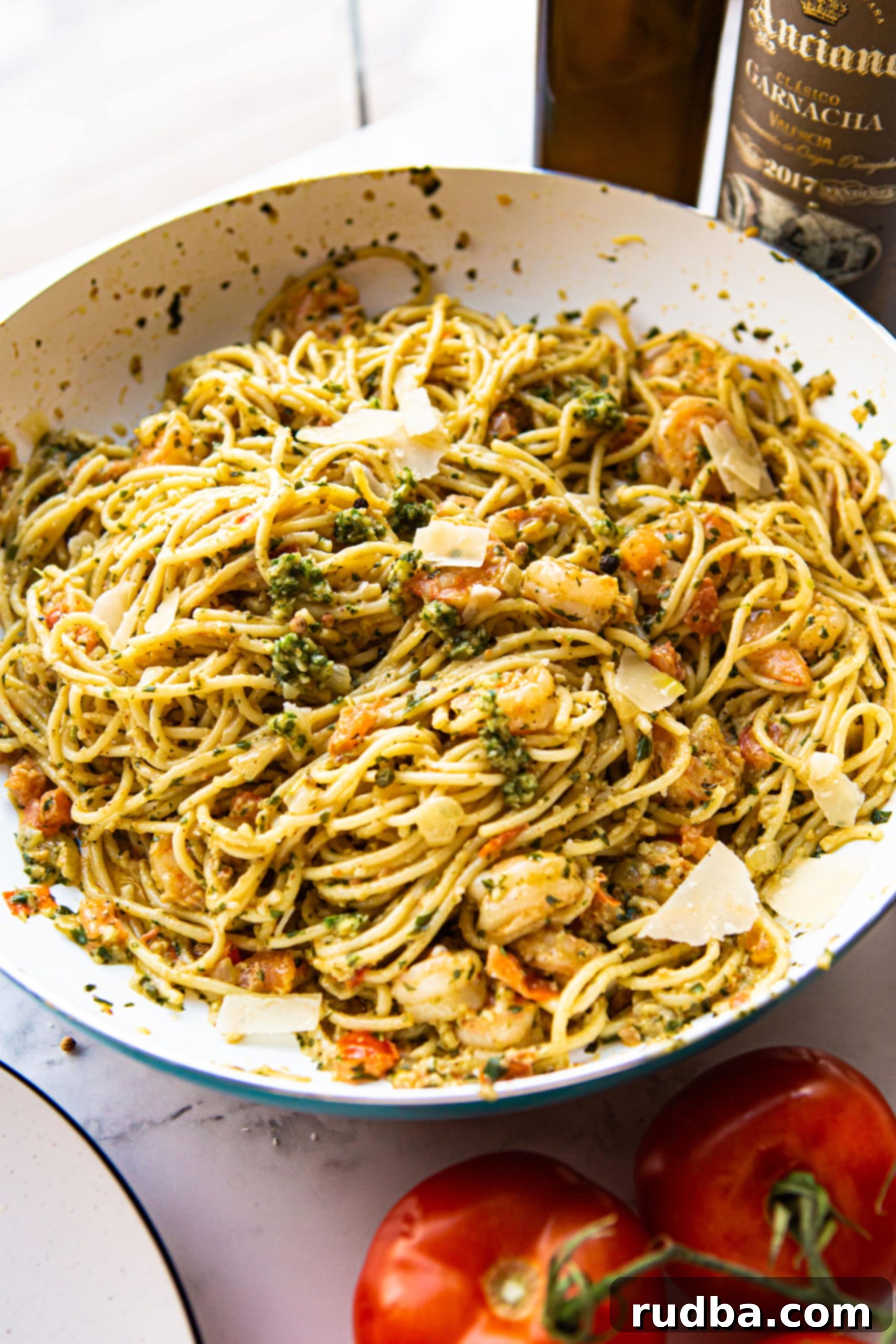
Storage: Keeping Your Leftovers Fresh and Delicious
Leftovers of this shrimp pesto pasta are just as delightful as the freshly made dish, provided they are stored and reheated correctly. To ensure maximum freshness and flavor, store any leftover pasta in an airtight container in the refrigerator for up to 4 days. This will help maintain its quality and prevent spoilage.
I do not recommend freezing this pesto pasta. The texture of the pasta tends to change significantly after being frozen and thawed, often becoming mushy. Additionally, the delicate flavor and texture of the shrimp can deteriorate upon freezing, resulting in a less enjoyable experience. For the best results, aim to consume this dish within the suggested refrigeration period.
When you’re ready to enjoy your leftovers, simply reheat them using the microwave or on the stovetop. If using the microwave, place the pasta on a plate and, to keep the pasta moist and prevent it from drying out, lay a damp paper towel over the top of the plate before heating. Heat in short intervals, stirring occasionally, until warmed through. On the stovetop, you can add a tablespoon or two of water or chicken broth to a skillet with the pasta and gently heat over medium-low heat, stirring until heated through. This method also helps to rehydrate the sauce and pasta.
This Shrimp Pesto Pasta is truly a dish that combines elegance with ease, making it a perfect choice for both busy weeknights and special occasions. The fresh, vibrant flavors of homemade pesto paired with tender shrimp and perfectly cooked pasta create a meal that’s both comforting and exciting. Give this recipe a try, and I’m confident it will become a new favorite in your culinary repertoire.
If you love pasta recipes as much as I do, then you will also adore this creamy chicken and bacon pasta. And for those who enjoy a bit of a kick, this buffalo chicken pasta is another reader favorite. You can find more delicious recipes and cooking tutorial videos on my Youtube channel and Facebook page. Happy cooking!
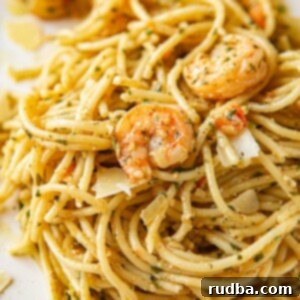
Pesto Shrimp Spaghetti
Save RecipeSaved Recipe
Pin Recipe
Rate Recipe
Print Recipe
Ingredients
- 1/2 lb shrimp
- 1 tbsp heavy cream
- 1 small onion
- 1 small tomato diced
- 1/2 tsp chili powder
- 1/2 lb spaghetti
- 1/4 cup pasta water
- salt and pepper to taste
Pesto
- 2 cups fresh basil leaves
- 2 garlic cloves
- 1/2 tbsp lemon juice
- 2/3 cup olive oil
- 1/4 cup pine nuts
- 1/2 cup parmesan cheese
- salt and pepper to taste
Instructions
-
Cook the pine nuts in a small skillet over medium-high heat for about 1 minute.
-
To make the pesto, place the basil, pine nuts, garlic, lemon juice, and parmesan cheese in a food processor and blend.
-
While the mixture blends, drizzle the olive oil through the feed tube.
-
Place the pesto in a bowl, season with salt and pepper and set aside.
-
Heat some oil and butter in a large skillet over medium heat and cook until the butter melts completely.
-
Place the onions in the skillet and cook for 3 minutes or until translucent.
-
Add the shrimp to the skillet, season with salt, pepper, and chili powder.
-
Cook the shrimp for about 2 minutes on each side then add the pesto to the skillet.
-
Cook the pesto along with the shrimp for about 1 minute.
-
Once the pesto is nice and hot, add the heavy cream.
-
Add the tomatoes and cook for 15 seconds.
-
Stir in the spaghetti and mix until the spaghetti is well coated with the pesto. Stir in the pasta water and check for seasoning. Add more salt and pepper if needed.
-
Serve with extra parmesan cheese and enjoy!
Video
Notes
Nutrition
Nutrition information is automatically calculated, so should only be used as an approximation.
Additional Info
Like this recipe? Leave a comment below!
